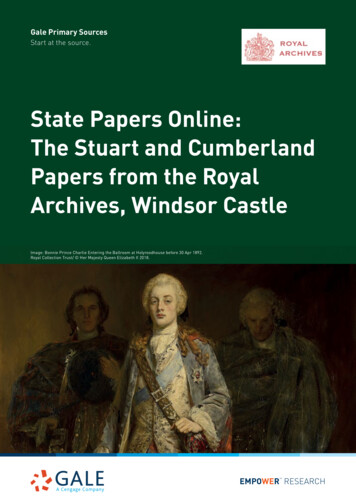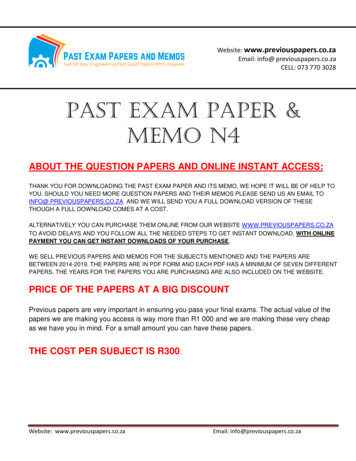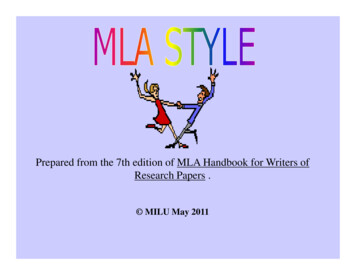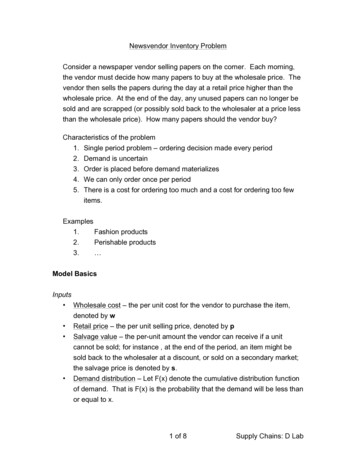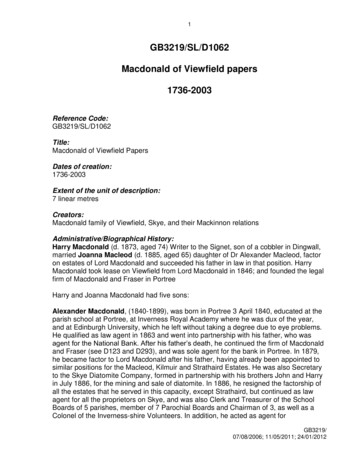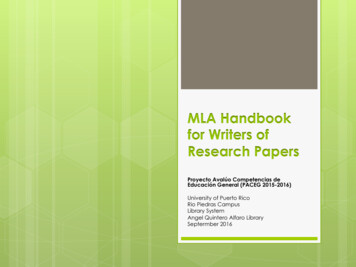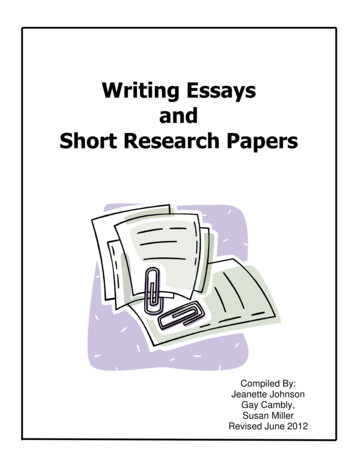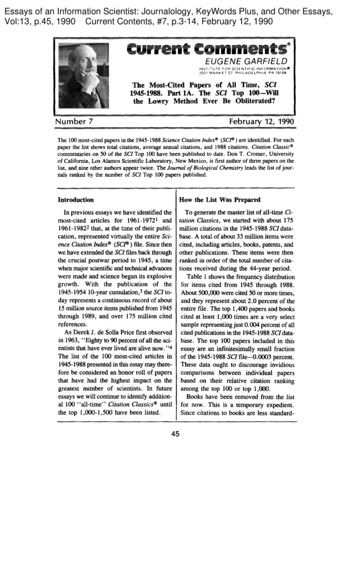
Transcription
Essays of an Information Scientist: Journalology, KeyWords Plus, and Other Essays,Vol:13, p.45, 1990 Current Contents, #7, p.3-14, February 12, 1990cu remtComm*n*s@EUGENE GARFIELDINSTITUTE FORSCIENTIFIClNFORMATlON@’3501 MARKET ST PHILADELPHIAPA 191C4INumberThe Most-Cited Papers of All Time, SCZ1945-1988. Part 1A. The SCZ Top 100---Wtithe Lowry Method Ever Be Obliterated?February712, 1990The 100 most-cited papers in the 1945-1988Science CitafionIndex” (SCF’) are identified. For eachpaper the list shows total citations, average annual citations, and 1988 citations. Citation Cfassic”commentaries on 50 of the SCI Top 100 have beerr published to date. Don T, Cromer, Universityof California, Los Alamos Scientific Laboratory, New Mexico, is first author of three papers on thelist, and nine other authors appear twice. The Joumaf oflliobgicaf Chem”srryleads the list of journals ranked by the number of SC] Top ICC)papers published.IntroductionHow the List Was PreparedIn previous essays we have identified themost-cited articles for 1961-1972t and1961-19822 that, at the time of their publication, represented virtually the entire Science Citation In&” (XP ) tile. Sirtce thenwe have extended the SCI fdes back throughthe crucial postwar period to 1945, a timewhen major scientific and techoical advanceswere made and science began its explosivegrowth.With the publicationof the1945-1954 10-yestr cutntdation,q the SC] today represents a continuous record of about15 million source items published from 1945through 1989, and over 175 million citedreferences.As Derek J. de Solla Price first observedin 1963, “Eighty to 90 percent of all the scientists that have ever lived are alive now.”4The list of the 100 most-cited articles in1945-1988 presented in this essay may therefore be considered an honor roll of papersthat have had the highest impact on thegreatest number of scientists. In futureessays we will continue to identifi additional 100 “all-time” Citation Ckzssics@ untilthe top 1,000-1,500 have been listed.To generate the master list of all-time Cifatiorr Classics, we started with about 175million citations in the 1945-1988 SCZ database. A total of about 33 million items werecited, including articles, Ixroks, patents, andother publications. These items were thenranked in order of the totaf number of citations received during the 44-year period.Table 1 shows the frequency distributionfor items cited from 1945 through 1988.About 500,000 were cited 50 or more times,and they represent about 2.0 percent of theentire file. The top 1,400 papers and bookscited at least 1,(X)Otimes are a very selectsample representing just 0.004 percent of aUcited publications in the 1945-1988 SCI database. The top 100 papers included in thisessay are an infinitesimally small fractionof the 1945-1988 SCI ffle-O.0003 percent.These data ought to discourage invidiouscomparisons between individurd papersbased on their relative citation rankingamong the top 100 or top 1,000.Books have been removed from the listfor now. This is a temporary expedient.Since citations to books are less startdard-45
Table 1: Citation frequency distribution for papersin the SCP, 1945- 198S. A number of citations,B number of items receiving thatnumber of citations.C percent of entire SCI tile.A 55,9847,877,213 62.583.333.699.0324.0755.78103.(XI* IeS [ha” o.01 percent of the SCI fde, 1945-1988.ized than article citations, considerable editing is required to unifi the data. Books areoften published in several editions, sometimes in several languages, and each editionmay be cited differently. Furthermore, specific pages or chapters of a book are oftencited, Since the SCI has deliberately keptthese as separate entries, it is a painstakingtask to unify all these “variant” citations.The most-cited books during 1945-1988 willbe the subject of separate essays in the future.The SCZ ‘TOP 100, 1945-1988Table 2 presents the top 100 papers in alphabetical order by first author’s name. Column A shows how often each paper wascited in the 1945-1988 SCI database, followed by its rank among the top 100.Column B shows the average annuaf citations for each paper, which is cafctdated bydividing total citations by the paper’s age.For example, the first paper listed in46Table 2, by Bruce N. Ames and colleagues,Department of Biochemistry, University ofCalifornia, Berkeley, received 4,583 citations. Dividing total citations by 14, thepaper’s age from publication in 1975through 1988, gives an average amual citation rate of 327. Column C shows thenumber of citations each paper received in1988. Comparing columns B and C will givean indication of whether a paper in 1988 wasrising or falling against its average afmuafcitation rate.Column D provides a full bibliographicreference for each work. An asterisk preceding a reference indicates that the paperwas the subject of a Citaiion Classic commentary, and the Current Contents” (C@’)issue, year, and edition in which the commentary was published follows the referencein parentheses. A dagger preceding a reference indicates that the paper did not appearon the previously published list of 100 mostcited papers for 1961 -1982.2The oldest of the SCf Top 100 papers isby Cyrus H. Fiske and YellapragadaSubbaRow, Harvard Medical School, Boston, Massachusetts, published in 1925 in theJournal ojBiological Chenristiy. Itdescribesa method for the colorimetnc determinationof phosphorus and has received 17,247 citations through 1988. The paper averaged269 citations per year over its 64 years,reached a peak of 597 citations in 1975, andhas since declined to 335 in 1988.The two youngest papers were publishedin 1980 by Alfan M. Maxam and Walter Gilbert, Department of Biochemistry and Molecular Biology, Harvard University, Cambridge, Massachusetts, in Methods of Enzymology and by Patricia S. Thomas, FredHutchinson Research Center, Seattle, Washington, in the Proceedings of the NationalAcademy of Sciences of the USA. (PNAS).The Maxam and Gilbert paper on a DNA-sequencing method was cited about 9,000times, with an annual citation average of justunder 1,000 and 1,258 citations in 1988.The Thomas paper on an RNA-hybridization method received over 5,00 3 citations
Table 2: Bibfiugraphy of the 100 mast-eked papers from the SCF, 1945-1988. Papers am arr-srrgcdalphabetically.A 1945-1988 citations, with 1945 -19gg rank in parentheses. B average numberof amuafcitations.C 1988citations,D bibliographicdata. An asterisk (*) indicates that the paper was the subject of a Citation Ckr.rsic”commentary. The issue, yrar, and edition of the commentary followthebibliographicreference,A dagger (t)indkates the paper dld nor appear on the 1961-1982 top 10II list,A4,583 (#58)4,232(# )6, 190(#39)4,648(#56)4,101 (#66)8,62g( #26)5, lo4(#53)3,488(#90)9,639(#19)7,516(#32)8,877 (U25)24,366(#3)3,565 (#86)9,922 (#17)13,4t?7(#l 1)5,463 (U49)5, 167(#52)3,594(#84)3,766W77)3,39’W94)4,014(U69)5 ,792(#46)4,111 (#65)17,510(#7)BDc246*Ames B N, MrCamr J & Yamasafd E. Methnds for detecting carcinogensand mutagens with the safmnnella/msrrmralian-microsome mutagenicitytest. hfukrr. Res 31:347-64, 1975. (12/84/LS)Andrewa P. Estimation of the molecrrfar weights of proteins by Scphadex70169gel-filtration. Bidtem. J. 91:222-33, 19fW.Arnon D L Copper enzymes in isolated cbforoplasts. Polyphenoloxidese in311155Beta vulgaris, Plant Physio[. 24:1-15, 1949,654273fAviv H & Leder P. purification of biologically active globin messengerRNA by chromatography on oligotbymidylic acid-cellulose. Proc. Mu.Acad. Sci. USA 69; 140g- 12, 1972. Barker S B & Srrmmersnn W H. The colorimetr-k determination of lactic2385acid in biological material. J. Biof. C/tern, 138:535-54, 1941, (46/83/LS)288399*BarUett G R. Phosphorus assay in column chromatographyy. J. Biol. Chem.234:466-8, 1959. (4/85/LS)937 * Birtrbufm H C & Duly J. A rapid afkafine extraction prucedure for510screening recombinant plasmid DNA. Nucl. Acid. Res. 7:1513-23, 1979.(45/88/LS)172Bitter T & Mrsfr H M. A mndtied uronic acid carbazole reaction, And.129Biochem. 4:330.4, 1%2.781321*Bffgh E G & Dyer W J. A rapid methnd of total lipid extraction srrdpurification. Can. J. Biachem. Physiof. 37:911-7, 1959. (52/78)3i17 Bnmer W M & Laakey R A. A fim detectionmethudfor tridum-latx]led501proteinsand nucleic acids in palyacrykurride gels. Eur. J. Biochern.46:83-8, 1974. (1/83/LS)713*S@rrnr A. Isolation of mononuclear ceffs and gremd ytes from human423blud. Scarrd. J. C/in. Lab. hwest. 21(Supp.97):77-89,1968. (45/82/LS)Bradford M M. A rapid and sensitive metbud for the qrmntitation of1,874 4.303microgram quantities of protein utilizing the principle of protein-dyebinding. Aml. Biochem. 72:248-54, 1976.6871Bratton A C & Marshall E K. A new coupling component forsulfsrrilamide determination. J. BioL Chem. 128:537-50, 1939.49*Bray G A. A simple efficient liquid scimillator for counting aqueous342solutions in a liquid scintillation counter. Anal. Biocherrr. 1:279-g5, 19 50.(2/77)483409*Bur@I K. A study of the conditions and mechanism of the diphen ylarrrinereaction for the calorimetric estimation of deox yribnnuc[eic acid. Biocfrem,J. 62:315-22, 1956, (26/77)206166*Chen P S, Turfbara T Y & Warner H. Micrndeterrnination of phosphorus.And. Chem. 211:1756-8, 1956. (9/77)517 1,602tCbirgwirI J M, Praybyla A E, MacDonsdd R J & Rutter W J. Isolationof biologically active ribunucleic acid from sources enriched inriburruclease. Birrchemistry-fJSA 18:5294-9, 1979.339 *?Cleveland D W, Fischer S G, Kfracfmer M W & Laemmli U K. Peptide300 PPing by limited protedysis in sndium dndccyl sulfate and analysis bygel electrophoresis. J. Biof. Cherrr. 252:1102-6, 1977. (41 /84/LS)70171*Corrney A H. Pharmacological implications of micror.nmaf enzymeinduction, Pharrmrcol. Rev. 19:317-61, 1967, (31791LS)540 *tCox D R. Regression models and life-tables. J. Roy. Srti’st, Sot. Ser. B2MJMetfro. 34:187-220, 1972. (421861AB; 421g61A&H; 421861S&BS)280211Cromer D T & Liberman D. Relativistic calculation of arromafousscattering factors for X-rays. J. C’hem. Phys, 53:1891-8, 1970.342Cromer D T & Mann J B. X-rey scattering factors computed from276nrrmericaf Hartree-Fuck wave finrctions. Acts Crysfa//ogr. A24:321-5, 1%8.57171Cromer D T & Waker J T. Scatrerin8 factors computed from relativisticDkac-Slater wave functions. Acfa Crywalfogr, 18:104-9, 1965.70UDavis B J. Disr electrophoresis-ff,Methud arrdapplication to human504sertmr proteins, Arm NY Acad. Sci. 121:404-27, 1964.32747
AuLD3,278W97)96884,009(#70)121359,741 (#18)2956113,591 (#85)103668,985 (#24)2644293,89W74)I30396,228(#38)2083314,372 (#61)1562927,084(#34)39424717,247(#8)26933520,505( #5)6419454,468(#59)2481764,589(#57)24211811,763 (#12)2942976,041 (#41)2632887,627 (#30)2933783,231 (#99)1291933,708(#82)982203,722 (#80)1092843,515 (#88)951566,294(#36)2333413,204 (#100)188494,045 (#68)2532514,756(#55)153781*de Duve C, Presaman B C, Ginnetto R, Wattiarrx R & Appebmrna F.Tksue fractionation studies. 6. Irrtrscelhdsr distribution patterns ofenzymes in rat-liver tissue. Biorhem. J. 643:604-17, 1955, (12/77)Dole V P. A relation between non sterified fatty acids in plasmsand themetabolismof glucose.J. Clin. Invest. 35: 150Lt, 1956.Duttoii M, Gfllea K A, Hamilton J K, Rebera P A & Smith F.Calorimetric metfmd for de.rerrrrinationof sugars and related substances.And. Chem. 28:350-6, 1956.Dulbeteo R & Vngt M. Plaque formation snd isolation of pure lines withpoliomyelitis viruses. J. Erp Med. 99:167-82, 1954. Duncao D B. Multiple range ruralmultiple F tests. Biorrretric 11:1-42,1955. (4177). . Engle H. Amino acid metatdism in nrsmmslian cell crdtures. Science130:432-7, 1959. (5/77)Elbmtrr G L. Tissue sulthydryl groups. Arch. Bidem.Biophys. 82:70-7,1959.*EUrrmrrG L, Courtney K D, Andrea V & Featberatone R M. A new andrapid colorimerric demminstion of acetylcholirresterase activity. Biochern.Pharrrraco[. 7:88-95, 1%1. (22177)Fairbanks G, Stedr T L & Wallaeh D F H. Electmphoretic snslysis of therrrsjorpnlypeptides of the hrrrmmerythmcyte nr-embrsne.Biochmri my– USA 10:2606-17, 1971.Fiike C H & SrrbbaRow Y, The colorirrretric determination of phosphors.J. Biol. Chem. 66:375-400, 1925.Fokh J, bra M & Slonrre Strtnfey G H. A simple method for the isolationand purification of total Iipides from animal tissues. J. Biol. Chem.226:497-509, 1957.GerrrrairrG, Main P & Woolfsrm M M. The application of phaserelationships to complex structures. III. The optimum use of phsaerelationships. Acka Crytallogr. A 27:368-76, 1971.Gibrmn A G. A protein bindirrg assay for adenosim 3’:5’%yclicmonophosphate. Proc. Mm, Aced. Sci. USA 67:305-12, 1970. Gmadl A G, Bardawill C J & David M M. Determination of serumproteins by means of the hiuret reaction. J. BioI. Chem. 177:751-66,1949. (13/79/LS)Grafmrrr R C & Karrrovsky M J. The early stages of absorption of injectedhorseradish peroxidase in the proximal tubules of mouse kidney:tdtrasrmctrmd cytochemismy by a new tdrnique. J. Hiskdtem. Cymdrem.14:291-302, 1966. Greenwmrt F C, Hrmter W M & Glover J S. The preparation of 131Ilabelled human growth hormone of high specific radioactivity. Biochem, J.89:114-23, 1%3. (15/77)*tHakomori S. Letter to edtor. (A rapid permethylation of glycolipid andpulysaccbaride catalyzed by methylsulfmyl carbanion in dimethylsulfoxide.) J. Biochem. -To@55:205-8, 1964. (23/80/LS)Hamburger V & Hamilton H L. A series of normal stages in thedevelopment of the chick embryo. J. Morphof. 88:49-92, 1951.*tHave] R J, Eder H A & Bragdon J H. The distribution snd chemicafcomposition of ukracenrrifugafly separated lipoproteins in human aemm.J. Clin. Invest. 34; 1345-53, 1955. (46/83/LS) Hodgkbr A L & Hmdey A F. A quantitative description of membranecurrent and its application to conduction snd excitation in nerve.J. Physid.-brdm117:W3-44, 1952. (28/81/LS)*Hrmter W M & Greenwnwf F C. Preparation of iodine-131 labefled humsrrgrowth hormone of high specific activity. Narure 194:495-6, 1%2,(26/89/LS; 26/89/CM; 26/89/ET; 26/89/PC) Jomfsd M, Hobrr G & Wigzefl H. Surface msrkers on humrm T and Blymphocytes. 1. A lsrge popoJation of lymphocytes forming nonimmunerosettes with sheep red blund cefls. J. E?p. Med. 136:207-15, 1972.(24/85/LS)Jufiua M H, Sknpamr E & Herzrnrberg L A. A rspid method for theisulation of frmctionsf thymusderived murine lymphocytes, Eur. J.Irrrrrmnol. 3:645-9, 1973. Kaplarr E L & Meier P. Norrparsmernc estimation from incompleteobservations. J. Amer. Sfdist AWL 53:457-81, 1958. (24/83/LS)48
ABC5,904(#44)2465,995 (#42)4284,3 fKf(#60)7759,759(#2)3,1453,994(#71)2853 ,913(#73)1709,3SX3(#21)1716,472(#35)162187,652(#1 )10,739(#14)4,9383849,531 (#20)3976,236(#37)2233,441 (#92)1325,474(#48)1965,178(#51)432it,995 (#23)9993,525 8(#22)6485,734(#47)2294,077 5 (#27)715D250 KnrnovskyM J. A forrnaldehyde-glutarafdehyde fmtive of high oamolafityforuaeirr elecrron rnicroacopy. J. Celf Biof. 27:137A-8A, 1965.(15/85/LS)633tKofder G & MfMefn C. Continuous cuftures of titaed cells secretingantibody of prcdetimd specificity. Nature 256:495-7, 1975.126*Kreba H A & Herraeleit K. Untersuchungen iibcr die Harnstoffbildung imTierki@cr (Studies on urea formation in the arrinud organism). HoppeSeylers Z. Pftysio/. C&r. 21033-66, 1932, (52/80/LS)8,896Laemroff U K. Cleavage of structural pmeeirrs during the assembly of thebead of bacteriophage T4. Nature 227:680-5, 1970,197 L.aakey R A & Mifk A D. Quantitative fflm detection of ‘H and 14C inpolyacrylamide gels by fluorography. Eur. J. Biachern. 56:335-41, 1975.(13/83/3-S)206 LaureU C-B. Quantitative estimation of proteins by electrophoresis inagarose gel containing antibodies. Armf. Biochem. 15:45-52, 1966.(51/80/LS)172*Lfneweavar H & Burk D. The deternrinarinn of enzyme disanciseioncmrstants. J. .4rrw. Cherrr. SW. 56:658-66, 1934. (11 /85fLS)249 LitcMeld J T & Wilcoxon F A. A simplified metfmd of evacuating doseeffect experiments. J. Hwrmrcof. .!@ i%er. 9699-113, 1949. (7/77)9,750*Lowry O H, Rasebrorrgb N J, Farr A L & Ranrtrdl R J. Proteinmeasurement with the Folin phenol reagent. J. Bid C&m. 193:265-75,1951. (1/77)126*Lnft J H. Improvements in epnxy resin embedding methnds. J. Biophys.Biochem. Cytol. 9:409-14, 1%1. (20/77)314Mancfrrf G, Carhmmra A O & Hererrmrss J F. fmmunnchemicaiqmmtitation of antigens by single radial irmnurrodiffosion.Immrurocherniwy 2:235-54, 1%5.214Marsrmr J. A procedure for the iaolstion nf dwxyritmnucleic scid frommicro-organisms. J. Mol. BioL 3:208-18, 1%1.316 tMarqunrdt D W. An algorithm for leaat-aqwes estimation nf nonlhcarparameters. J. Sot. fnd. Appf. Math. 11:431-41, 1%3. (27/791ET)122Mortfn R G & Ames B N. A m-ethcd for determining the sediienrationbehavior of enzymes: application to protein mixtures. J. Bid Chem.236:1372-9, 1%1,362Masarn A M & Gilbert W. A new method for wquencing DNA. Proc.Nat Acad. .%f. USA 74:560-4, 1977.1,258tMaxmA M 8r Gffbert W’. Sequencing end-labelled DNA with basespecitic chemical cleavages. hfeth. Ewymdogy 65:499-560, 1980.Monor3 J, Wyman J & Changerrx J-P. On the nature of akatericlaltransitions: a plausible nmdel. J. Mnf. Bid. 12:8g-118, 1965.33*Moorhead P S, Noweft P C, Melfnmn W J, Battlpa D M & Hunger’fordD A, Cfrmmoaome preparations of leukocytes cufturcd from bmnarrperipheral blood. Ezp. Cell Res. 206134,1960. (7/83/LS)659 MuraaMge T & Skoog F. A revised medium for mpid growth andbioasaays with tobacco tissue crdtures. Physid Pkru. 15:473-97, 1%2.(43/78)187*Nelsmr N. A phntometic adaptation of the Snrnogyi methnd for thedetemrinatinn of gfucoae. J. Bio[. Chem. 153:375-S0, 1944. (3/77)883*0’FarreU P H. High reanhrtion two-dimensional el trophoresis of prntcins.J. Bio!. CYrsvn.250:4007-21, 1975. (51/82ilS)Omura T & Sato R. The carbon nrrmoxide-binding pigment of liver371micrnsomea. L Evidence for its hemoorotein nature. J. Biol. Chem.239:2370-8, 1964.73Ornatefo L. Disc electrophoresis-LBackground and theory. Arm. NYAced. Sci. 121:321-49, 1964.6Pafade G E. A stndy of fixation for electron microscopy. J. Erp. Med.95:285-97, 1952.23Reed L J & Muench H. A simple method of estimating 50 pmcentendpoints. Amer. J. Hyg. 27:493-7, 1938.44*Reynofrk E S. Tbc use of lead citrate at high pH as an elcctror paquestain in electron rnicrnscnpy. J. Celf BioL 17:20g-12, 1%3. (32/81 /LS)1,177tRtgby P W J, Dieckman M, Rhodes C & Becg P. Labelingdeoxyribonucleic acid to high specific activity in vitro by nick translationwith DNA prdymeraae I. J, Mo{. Bio[. 113:237-51, 1977.49
A5,904(#43)-.BuSnhatird D D, Berrach K & Ekmrnett R J. Cytnchemistry and ,365 (#50)158343,715 3I 123,507 1 1(K33)3713893,727 (#79)1%3598,079(#28)3372925 ,761 (#78)2091444,255(#63)177763,306(#96)69316,081 (#@)2031603,945(#72)1273920,672(#4)I ,0345753 ,478(491)3,666(#83)15814712346microscopy: the preservation of cellular ukra.structure rmd enzymaticactivity by aldehyde fmtion. J. Cd Bid. 17:19-58, 1%3.%nnger F, Niikferr S & CotierA R. DNA sequencing with drainterminatiog infribbors. Prrm Nat. Acad. Sci. USA 74:5463-7, 1977.(m/EE/f-S)scatchard G. The attractions of proteins for small molecules and ions. Ann.NY Acad. Sri. 51:660-72, 1949.Seheidegger J J. UrE rnicrn-m&hode de l’immutilectropbnr se(A micromcthnd for irmmmuclectrophoresis). hr. Arch. Affergy 7:103-10, 1955.Schmidt G & Thrrrhauaer S J. A method for tbc determirration ofdeoxyribonucleic acid, ribnnucleic acid, mrd phosphoproteins in animaltissues, J. Biol. C-hem. 161:83-9, 1945.*tScfmeJder W C. Phosphorus cnmpourrds in animal tissurs. 1. Extraction andestimation of desnxypcntnse nucleic acid arrdof pcntrme nucleic acid.J. Bid. Cherrr. 161:293-303, 1945. (8/77)Shapirn A L, Vhruela E & Mabel J V. Mokcular weight estimation nfpnlypepdde chains by electropboresis in SDS-pnlya@arnidegels.Biochem, Biophys, Res. Cbrrrmurr.28:815-26, 1%7.Wrrger S J & NicoLsmrG L. The fluid mnsaic model of the SUUCNre of cellmembranes. Science 175:720-31, 1972. (46/77)Snmngyi M. Notes mr sugar determination. J. Biol. Chem. 195:19-23,1952.southern E M. Dctrction of specific sequences among DNA fragmentsseparated by gel elcctrophoresis. J. Mol. Bid. 98:503-17, 1975.Spackrnan D H, Stein W H & Monre S. Automaticrccnrdinga tusfor use in the chromatography of amirrn acidx. Arraf. Chem. 301190-206,1958.%purr A R. A Iow-viscnsity epnxy resin embedding mcdimn for elmtronmicroscopy. J. Ultrastruct. Res. 26:3143, 1%9. (501791LS)* S emherger L A, Hrrrdy P H, Cuculis J J & Meyer H G. The urdabelcdaertibndy enzyme methnd of inmmrrobistocherrrky: preparation audproperties of soluble arrtigen-arrtibndycomplex (horseradish peroxidascrmtibomeradish ptroxidasc) arrd its use in idcntifkation of spirnchetcs,J. Hi.rtochem. Cytachem. 18:315-33, 1970. (4/83/LS)*Stewart R F, Davidaurr E R & Sfmpann W T. Coherent X-ray scatteringfor the hydrogen atom in the hydrogen molecule. J. Chem. Phys,42:3175-87, 1%5, (48/77)tTfmmaa P S. Hybridization of dcmtured RNA and small DNA fragmentstransferred to nitrnceflulose. Proc. Nat. Acad. . ci. USA 77:5201-5, 1980.*tTowbin H, StaehWrr T & Gordon J. Electrophoretic transfer of proteinsfrnm prdyacrylamide gels to rritrndfrdose sheets: prncedure and snmeapplications, Proc. Nut, Aced. Sci. USA 76:4350.4, 1979. (11 /88/LS;11/88/cM)VrevelyanW E, Procter D P & Harrison J S. Detection nf sugars onpaper cbrornatogmms. Nature 166:444-5, 1950. (6/77) Vnne J R. fnbibition of prnstaglaudin synthesis as a mczbanism of actionfor aapirirr-lie drugs. Nature New Biol. 231:232-5, 1971. (42/80/LS) Venable J H & Coggcshnff R. A simplifki lead citrate stain for use inelectron rnicrnscopy. J. Cell Birrl. 25:407-8, 1%5. (10/77)Warburg O & Christian W. Isrdienmg und Kristallisation desGiirungsfermerrts Enolase (Isolation and crystallization of the enzymeenolase). Biochem. Z 310:384-421, 1941.*Warren L. The tbiobarbituric acid assay of sialic acids. J. Biol. Chern.234:1971-5, 1959. (36/77)Watamr M L. Staining of tissue sectinns for electron microscopy with heavymetals. J. Biophys. lfirrcherrr. Cyto/. 4:475-8, 1958.Weber K & Osbnm M. The reliability of molccrdar weight determinationsby dudecyl srdfate-pnlyacrylarni& gel elcctrophorcsis. J. Biol. C7rerx.244:4406-12, 1%9.Wefnberg S. A mndel of leptons, Phys. Rev. La. 19:1264-6, 1%7,Ypfmntis D A. Equilibrium ultmcentrifugatinn of dilute snlutions,Biocherrristry-USA 3:297-317, 1964.50
Figure 1: Distribution of SCP citations to papers 00 extraction, Math,and sequencing of DNA frmn thelist of the 100 most-eitrd papers in Table 2. Yearone represmm rhe year each paper was published, and citationgrowth is measured year-by-year. .---------——— — –for each papx through1988.Sanger F at al. Ptvo. Nat Aead SCL USA 7454 2-7,1977.!Wtfrarn E M. il. Mol. B/o/. 9S50S-17, 1975.55:4WSS0, 19S0.kMxamA Mat al. M@h. Enzymology7homas P S. We. Nat. Acsd Sel. USA W.5201-S, 19S0.Maxam A Met al. Ptve. Nat Aead. Sd. USA 74SS04, 1977.3,500113,000.,.-/.I{2,50@l 2,(loo0 s 1,500%!aI/’-’-- 121314AgrJof Paperfor an annual average of 561, compared to8% citations in 1988. These papers reachedcitation peaks of 1,404 and 987, respectively, in 1987. Figure 1 presents a graph of the“citation trajectories” of these high-impactDNA methods papers and three others-a1977 paper by Maxam and Gilbert, a 1977paper by Frederick Sanger and colleagues,Medical Research Council LahratoryofMolecular Biology, Cambridge, UK, and a1975 paper by Edwin M. Southern, Department of ZOOlogy, University of Edinburgh,Scotland.Two papers in Table 2 were published inGerman-byHans A. Krebs and KurtHenseleit, then at the University of Freiburg, Germany, in 1932 (4,380 citations,1945-1988) and by Otto Warburg and Walter Christian, Kaiser Wilhelm Institute forCell Physiology, Berlin, Germany, in 1941(3,306 citations). The Krebs and Henseleitpaper is a classic “concepts” rather thanmethods paper. It explained a biological process in terms of its underlying biosyntheticchemical pathways. The WarL”ug andChristian paper reports a method for preparing samples of the enzyme enolase. Bothpapers reached citation peaks at late ages,with 185 citations in 1980 for the Krebspaper and 150 citations to Warburg in 1972.One might have thoughtthat theseGerman-language papers would have beencited more heavily in their early years, whenGermany was still a dominant scientificpower. In his Cilaion Classic commentary,Krebs reminds us of another, more chillingkind of pwer when he says that his coauthor, Henseleit, was forced to leave researchfor mdlcal practice after being told’ ‘by theHitler regime that there was no future forKm in academic medicine.”sOne French-language article is also on thelist. The 1955 paper by J.J. Scheidegger,Polyclinic of the Medical School, Geneva,51
Switzerland, describes a micromethod forimmunoelectrophoresis.It received 5,365citations through 1988, averaged 158 citations amually, and reached a peak of351in 1970. The paper was cited 34 times in1988.One of the SCI Top 100 papers is a letterto the editor. In a 1980 Ciration Classiccommentary,6 Sen-itiroh Hakomon, then atthe Department of Biochemistry, Institutefor Cancer Research, Tohoku Pharmaceutical School, Sendai, Japan, recalled firstsubmitting his paper to the Journal of Biochemistry (Tokyo) in June 1963, but hequickly withdrew it because of criticismfrom a preprint reviewer. Equally but oppositely impelled by a colleague’s forcefulencouragement, he resubmitted the manuscript in November 1963, and it was eventually published as a letter in February 1964.It wentontoreceive3,231citations through1988, achieved an annual average of 129 citations, peaked at 234 in 1981, and was cited193 times in 1988.As a final highlight of the list, there is onephysics paper among the SC7 Top 100-a1967 “concepts” paper by Steven Weinberg, then at the Department of Physics,Harvard, that presents a model of Ieptons;this paper was cited about 3,500 timesthrough 1988. It averaged 158 citations peryear, peaked in 1980 at 333, and was cited123 times in 1988. We’ll present citation trajectory curves of high-impact physics paperslater in this series, when their numbers aremore significant, and compare them withgraphs from other fieids.Citation Ckzssics SuperstarsSince 1977 ISI@ has published over 3,000Citation Ck2ssic commentaries on frequentlycited papers and books in virtually all thefields represented in the SC1 and the SocialSciences Citation hrdex@ databases. In thesecommentaries the authors themselves describe what their landmark papers are aboutmd suggest their own reasons why theseworks have gone on to become so highlycited. Indeed, personal commentaries on exactly half of the 100 papers listed for1945-1988 have been published. These 50papers are indicated in Table 2 by anasterisk. One more Citation Classic commentary in Table 2, on the paper by RichardC. Graham and Morris J. Kamovsky, Department of Pathology, Harvard MedicalSchool, is in production as we go to press.That means there are still 49 papers webelieve ought to be represented in the Ci/a-Figure 2: Year-by-year dktributionof citationafrom the SCP, 1970-19S8,for tbe fonr top cited works fromthe tiat of the 100 moat-cited papers in Table 2.—— —— - Lowry O Hat al. J. Biol. Chem. 193:265-75,1951.Laemmll U K. Afafure 227:680-5, 197o.---------Bradford MM. Anal. 810chem. 72248-54,1976. . . . . . . . . . . . . . Weber K & Oaborn hi. J. B1oI. Chem. 244:4406-12, 1969.12,000-1/— —-.10,000 /s 8,000g--:6,000-//“/\\,/1 .”—-- ,\,/T,/’ /E 4,000-“,/z2,000-.,0.”19701971 1972197319741975197619771978 19791980198119821983 198419851980 19871988Year----------------------52
tion Classics series. This essay is an openinvitation to the coauthors, or their colleagues, of papers in Table 2 not alreadypublished as Citation Ckssic commentaries(those without an asterisk) to contact us.With their help, we welcome the opportunityto extend the record of personal ‘‘biographies” of Citation Ckssic papers.by Lasnrtrrdi on the list (see Table 2), tiedtogether two of the top-cited papers in Table 2 in a Citation Classic commentary:As a result of its speed, resolving power,adaptability,and ease of use, @yacrylarnide gel electrophoresisin the presenceof the detergent sodium dodecyl sulfate isthe most widely utilized method for thedetermination of both the purity and molecular mass of polypeptides in proteinSSMPleS. This simple, but powerfu[, t.schnique, first popularized by Weber andOsbom [ 1969, see Table 2] and improvedby f-aernmli [ 1970, see Table 2], remainsthe centermost of available methods forpolypeptide analysis and characterizationmore than 16 years after its irrtroduction. 8Has Lowry Peaked?It was entirely appropriate that Oliver H.Lowry, School of Medicine, WashingtonUniversity, St. Louis, Missouri, and colleagues’ landmark paper on protein determination was the subject of the first Citation Classic commentary,7 published in CCin 1977. In the history of science, there hasnever been another paper that has comeclose in terms of total or annual citationcounts. Whatever accounts for this phenomenon, explicit citations to the Lowry methedseem to be declining somewhat but are stillhigher than any other.Laenunli’s “improvement” paper has received more than 59,000 citations, nearly9,000 in 1988 alone, whiie Cleveland’s 1977paer (see Table 2) has received about 3,600citations, with nearly 340 in 1988. Weberand Osborn’s 1969 paper (see Table 2) received more than 20,600 citations between1969 and
entire file. The top 1,400 papers and books cited at least 1,(X)Otimes are a very select sample representing just 0.004 percent of aU cited publications in the 1945-1988 SCI data-base. The top 100 papers included in this essay are an infinitesimally small fraction of the 1945-1988 SCI ffle-O.0003 percent. These data ought to discourage invidious

